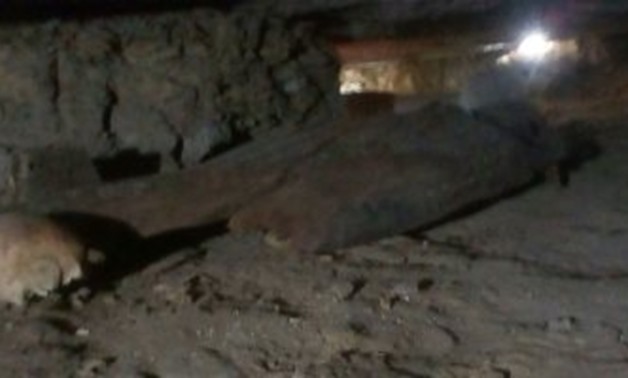https://www.egypttoday.com/Article/4/43713/8-new-tombs-discovered-in-Tuna-el-Gebel-in-Minya
 The discovered statues - Egypt Today
The discovered statues - Egypt Today 8 new tombs discovered in Tuna el-Gebel in Minya
By: Angy Essam
Sat, Feb. 24, 2018
CAIRO – 24 February 2018: The Egyptian Minister of Antiquities Khaled Anany announced Saturday the discovery of 8 tombs that contain about 40 coffins of Pharaonic priests and more than 1000 Ushabti statues in Tuna el-Gebel area in Minya Egyptian governorate.
"Today we are announcing the beginning of a new discovery, the tombs are full of jewelries, potteries and pharaonic jars,'' Anany recounted.
This discovery as described by Anany is one of the largest and most important archaeological discoveries unearthed in recent times. The new archeological discovery is documenting some issues related to the live of ancient Egyptians in Minya province tens of centuries ago.
The most prominent finds in these tombs were a gold mask, coffins, mummies and statues.The Egyptian ministry of Antiquities added that the area of the discovery requires years of hard work pointing out that the main advantage of this discovery is that it was discovered by Egyptians.
It is worth mentioning that this discovery is considered the second discovery in 2018 after a new tomb was discovered in the Western Cemetery located in the Pyramids area in Giza to an ancient Egyptian woman named Hetpet, as announced on February 3 by Anany.

The discovered statues - Egypt Today
Hetpet was a woman with a high social position in ancient times. She has number of cognomens from them is the Priest of the goddess Hathour. Hathour is a pharaonic goddess who symbolizes the principles of joy, feminine love, and motherhood.
Anany previously elaborated that the excavation work in this area started in October 2017 and will continue in 2018 under the supervision of Mostafa el-Waziry the secretary-general of the Supreme Council of Antiquities. El-Waziry previously announced that Hetpet played important roles at that time especially in the agricultural field.
"The tomb contains a group of dazzling inscriptions portraying rare amazing scenes like a monkey dancing in front of a complete musical troupe, a sailors' fight, hunting birds, and fishing among others. All the inscriptions colors are very clear and bright," el-Waziry announced after the discovery.
The tomb dates back to the Fifth Dynasty from about 4,400 years ago. The Western cemetery area was reserved for senior officials in the pharaonic area. The famous Egyptian archaeologist Zahi Hawass has previously discovered a group of ancient Egyptian tombs in this area.
Archaeologists at Cairo University have discovered catacombs including 18 non-royal mummies in Tuna el-Gebel on Saturday May 13, 2017. The burial shafts were found in the area, adding that the shafts led to a number of corridors inside a cachette of mummies. This discovery was the first human necropolis found in central Egypt with so many mummies.
Tuna el-Gebel in the city of Mallawi was the necropolis of Khmun. It contains monuments from the Greek and Roman eras, as well as the Late Middle Ages. The area hosts the Boundary Stelae of Akhenaton, catacombs of falcons, baboons and ibises, and the tombs of Petosiris and Isadora.
Tuna el-Gebel village is famous for having many archaeological tombs, which contributed greatly to the revival of archaeological and touristic life, and helped drive Arab and foreign tourists to the region once again. It is an archaeological village located in Al Minya Governorate. It has a population of more than 20 thousand people.
Tuna el-Gebel was originally named "Towns'' in the Pharaonic era. It was named Tahnet in the Roman era. The meaning of both names is the blessing or flood. Tuna el-Gebel was considered a cemetery in the Pharaonic, Greek and Roman periods that contains many important monuments including the tomb and the chapel of Isadora, the martyr of love, which dates back to the Greco-Roman period.
Tuna el-Gebel houses the tomb of the priest ''Petosiris'' dating back to the Greek era, the villa of the Dean of Arabic literature Taha Hussein, in addition to the existence of many archaeological sites that have not been discovered yet waiting to be revealed to the world.

The discovered statues - Egypt Today
-- Sent from my Linux system.
No comments:
Post a Comment